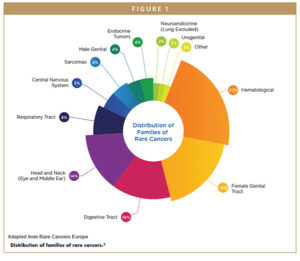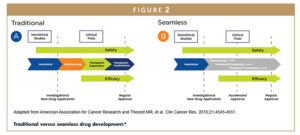Issue:November/December 2021
MARKET BRIEF - Navigating the Evolving Landscape of Rare Cancer Trials
INTRODUCTION
Rare cancers account for 27% of all new cancer diagnoses in the US and 22% of all new cancer diagnoses in the EU.1 With the shift toward grouping cancer based on molecular subtypes rather than by location and tissue type, some common cancers are now categorized as groups of rare cancers. For example, melanoma as a whole is not considered a rare cancer, but when divided into molecular subtypes, it can be viewed as a collection of rare cancers. When grouped as families, the most common rare cancer types are hematological, female genital tract, gastrointestinal, and head and neck malignancies.2
Grouping cancer based on molecular subtypes has changed not only how tumors are categorized, but also how novel therapeutics are studied in clinical trials. In this discussion, we explore the landscape of rare cancer clinical trials, from key considerations for study design and the value of biomarkers to the importance of the patient perspective and the options for speeding much-needed therapies to market.
DEFINING RARE CANCERS
There is no universally accepted definition for a rare cancer. In the US, rare cancers are defined as those with fewer than 15 cases per 100,000 per year. In the EU, however, cancers are considered to be rare if they occur in six cases per 100,000 per year.
While rare cancers are sometimes called the rare diseases of oncology, the terms are not synonymous. From a clinical trial perspective, there is some overlap between rare cancers and rare diseases — namely small and geographically dispersed patient populations, diagnostic challenges, poorly understood natural histories, and statistical hurdles stemming from small sample sizes. There are, however, some key differences:
How they are defined – Rare diseases are defined by prevalence, while rare cancers are defined by incidence.
The role of genetics – 80% of rare disease have a genetic basis, whereas few rare cancers have a well-defined genetic component.
How they affect children – 75% of rare diseases affect children, and while childhood cancers are less common than adult cancers, every pediatric cancer is considered rare.
The approach to target discovery – Rare diseases comprise a heterogeneous collection of diseases with unique targets, while rare cancers fall under the larger cancer umbrella and may benefit from discoveries in common cancers.
RARE CANCERS & PRECISION MEDICINE
Surgery, radiation, and chemotherapy were the mainstays of cancer treatment for many decades, but precision medicine has transformed the oncology landscape. With advances in genetics and technology, it is now possible to offer customized care based on the molecular characteristics of a particular tumor. In recent years, there have been breakthrough developments of tumor- or tissue-agnostic therapeutics. Three such therapies have received regulatory approval to date:
Pembrolizumab – for tumors with microsatellite instability-high (MSI-H) or deficient mismatch repair (dMMR).
Larotrectinib – for tumors with neurotrophic tyrosine receptor kinase (NTRK) gene fusions, which are found in approximately 0.3% of patients across various cancer histologies.
Entrectinib – also for tumors with NTRK gene fusions.
Larotrectinib is the first drug developed entirely using an agnostic approach. Its approval was based on efficacy data derived from three separate open-label, single-arm trials. Designed as basket studies, these trials included patients with 12 different solid tumor indications, all with the same NTRK gene fusion and all of whom were treated with larotrectinib. The overall response rate was 75% across all three trials. Approval was based on pooled data from only 55 patients and the time from Phase 1 to accelerated approval was only 3 years, highlighting the potential efficiency of adopting a biomarker-driven approach to innovative drug development.
MOVING TOWARD SEAMLESS DRUG DEVELOPMENT
An increasing number of rare oncology programs have transitioned from a traditional, sequential drug development pathway to a seamless one. In seamless drug development, pharmacology, therapeutic exploratory, and therapeutic confirmatory studies are combined, with the goal of achieving accelerated approval.
Cross-functional alignment across clinical, regulatory, manufacturing, and marketing is essential for meeting the shortened timelines of seamless drug development. Rare oncology sponsors who are considering this approach will need to account for the following:
Population size – The number of patients in the final dataset will be low, so innovative trial designs and statistical methods for data analysis may be required.
Recruitment strategy – For successful enrollment, broad geographic reach will likely be necessary, increasing study cost and complexity.
Study design – It is critical to define the study population and subgroups, methodology for response assessment, and endpoints. Biomarkers may be more sensitive than tumor measurements for gauging response, especially with targeted therapies and immunotherapies. If overall survival is an endpoint, it is also important to determine how to manage patients who progress after initial treatment.
Genetic or biomarker testing – Sponsors will need to identify an appropriate testing kit and testing methodology early in the program. The kit and methodology should be fit for purpose based on the development phase, but also scalable for late-stage studies and commercialization.
Manufacturing – With an accelerated program, manufacturing will need to scale quickly while remaining compliant with regulatory requirements.
THE ROLE OF ADAPTIVE DESIGNS IN RARE CANCER TRIALS
Adaptive designs are study designs that allow for prospectively planned, pre-defined modifications to be made based on analysis of accumulating data at predetermined points in the trial. These designs can be used to optimize rare cancer trials, allowing for additional flexibility, increased efficiency, and more targeted study populations. Adaptive designs commonly used in rare oncology trials include:
Seamless Phase 1/2 – where a Phase 1 study focused on dose-finding transitions directly into a Phase 2 expansion study focused on efficacy.
Biomarker enrichment – which uses biomarkers as inclusion/exclusion criteria, with the goal of identifying patients who are most likely to respond. An alternative to this approach is biomarker stratification, where biomarkers are measured on all patients and are used as stratification variables.
Umbrella – which evaluates multiple targeted therapies for a single disease by stratifying patients into subgroups based on tumor molecular characteristics.
Basket – where a single targeted therapy or therapy combination is investigated in a variety of cancer types that share common underlying molecular alterations.
Notably, adaptive designs are not mutually exclusive, and multiple methods may be used in a single trial.
THE BENEFIT OF BIOMARKERS
Use of biomarkers for patient selection and treatment response monitoring has increased significantly. Research has shown that studies using biomarkers for patient selection are both more likely to advance at every stage of development and more likely to gain regulatory approval. In Phase 3 trials, studies employing biomarkers are nearly twice as likely to succeed as those that do not.5
Biomarker testing methodologies are myriad. Next-generation sequencing (NGS), which enables a broad spectrum of genomic alterations to be analyzed simultaneously, has been a driver of precision medicine in oncology. NGS can be applied to specific genes, off-the-shelf or custom gene panels, whole exomes, or even the entire genome. Coupled with decreases in sequencing costs and increases in efficiency, NGS has fueled a paradigm shift in biomarker discovery and targeted drug development.
NGS generates a massive amount of data, but not all genomic information is clinically relevant. It is, therefore, important for sponsors to develop a strategy for sifting through and interpreting the data to assess its clinical significance. In addition to leveraging online genomic knowledge bases, sponsors may find it useful to create precision medicine teams or molecular tumor boards to assist in data interpretation. Liquid biopsies — which may be blood, plasma, or other bodily fluids — are also poised to be indispensable biomarker tools. Traditional tissue biopsies are associated with certain limitations such as availability, invasiveness, cost, and inability to perform multiple assessments. With liquid biopsies, it is possible to perform cost-effective serial sampling for longitudinal assessment and downstream analysis.
INCORPORATING THE PATIENT PERSPECTIVE
Successful rare cancer studies require strong patient advocacy and engagement. Imatinib, a type of chemotherapy, is a classic example of how the internet can inspire patient activism and impact drug development. When reports of remission with imatinib treatment in a Phase 1 study circulated in the early 2000s, patients clamored for increased clinical trial activity and drug production, spurring a Phase 2 trial and, ultimately, approval.
Technology has been a powerful enabler of patient involvement in drug development. Social media platforms facilitate knowledge sharing at scale and offer opportunities for sponsors to learn more about the patient perspective. This is especially important in rare cancer research, in which patients are searching for options and might be willing to accept different levels of treatment-related risk. Facebook groups and other online forums bring together patients with rare cancers, allowing sponsors to reach out to patients for feedback. An increasing number of nonprofit organizations such as Count Me In are seeking to connect patients with researchers to accelerate discovery and development of novel treatments. The ability to interact with geographically dispersed patients not only facilitates recruitment but also broadens access.
ACCELERATING THE PATH TO APPROVAL
Given the limited arsenal of treatment options available for most rare cancers, time is of the essence in drug development. The 2020 approvals of tazmetostat for advanced epithelioid sarcoma and selumetinib for neurofibromatosis type 1 signal the FDA’s commitment to prioritizing the unique needs of rare cancers. Recognizing that certain aspects of drug development for common diseases may not be feasible for rare cancers, the agency has demonstrated a willingness to offer additional flexibility.
In the US, there are a number of regulatory mechanisms available to help expedite rare oncology program, including:
Fast track designation – To qualify for fast track designation, a therapeutic must be intended to treat a serious condition, and there must be nonclinical or clinical data demonstrating its potential to address an unmet medical need. Alternatively, the therapeutic must be designated as a qualified infectious disease product. This designation can be rescinded if the therapy no longer meets the qualifying criteria.
Breakthrough therapy designation – Like the fast track designation, the breakthrough therapy designation applies to therapeutics intended to treat a serious condition and can be rescinded. To qualify as a breakthrough therapy, however, there must be preliminary clinical evidence indicating that the product may demonstrate substantial improvement on at least one clinically significant endpoint over available therapies.
Accelerated approval – This pathway is intended for therapeutics that treat a serious condition, provide a meaningful advantage over available therapies, and demonstrate an effect on a surrogate endpoint that is reasonably likely to predict clinical benefit or on an intermediate clinical endpoint. Sponsors who are interested in pursuing accelerated approval should discuss their plans with the FDA review division early on in development. In general, the FDA will request that confirmatory studies be underway at the time of accelerated approval.
Priority review designation – The priority review designation requires that a drug is intended to treat a serious condition and, if approved, provide a significant improvement in safety or effectiveness. Other submissions that might qualify for priority review include supplements that propose a labeling change pursuant to a pediatric study, applications for drugs designated as qualified infectious disease products, and submissions accompanied by a priority review voucher.
PRIME – In the EU, PRIME is the main mechanism for expediting development of medicines targeting unmet medical needs. PRIME provides enhanced interaction and early dialogue with regulators to help ensure generation of robust data and enable accelerated assessment of marketing authorization applications. Key benefits of PRIME include appointment of a rapporteur for continuous support, organization of a kick-off meeting for guidance on the regulatory strategy and overall development plan, assignment of a dedicated contact point, and provision of scientific advice at key development milestones.
SUMMARY
Rare cancers represent a significant unmet need in oncology. Globally, more than one in five cancer patients is living with a rare cancer and faced with limited treatment options. With advances in genomic testing, immunotherapy, and precision medicine, progress is being made, bringing new treatment alternatives to the patients who need them.
REFERENCES
- Greenlee RT, et al. The occurrence of rare cancers in U.S. adults, 1995-2004. Public Health Rep. 2010;125(1):28-43.
- Based on data from RARECARENet. Available at www.rarecare.eu.
- Rare Cancers Europe. “Families” and List of Rare Cancers. Available at https://www.rarecancerseurope.org/about-rare-cancers/families-and-list-of-rare-cancers.
- Theoret MR, et al. Clin Cancer Res. 2015;21:4545-4551.
- Wong CH, Siah KW, Lo AW. Estimation of clinical trial success rates and related parameters. Biostatistics 2019;20(2):273-286.
To view this issue and all back issues online, please visit www.drug-dev.com.

Dr. Rupa Doshi is Vice President, Program Strategy, Oncology at Premier Research. With more than 23 years in the industry, she is an experienced professional with demonstrated leadership skills in clinical operations, global project/program management, customer management, and strategy development. Her experience spans the clinical development spectrum from pre-IND to NDA. She has also led global teams to execute full-service complex clinical trials across all phases. She brings drug discovery and clinical development experience with biologics and small molecules as well as cell and gene therapy products over a range of indications. Her doctoral research focus was on breast cancer, while her post-doctoral research was in site-directed mutagenesis. She holds patents in angiogenesis and has also supported three products resulting in agency approval.

Dr. Sameena Sharif is President, Regulatory Professionals, A Division of Premier Research. She is a strategic thought leader in drug development, alliance, project, and portfolio management. She has broad experience in managing projects at all stages of drug development — from the target selection and pre-investigational new drug stages through new drug application/marketing authorization application submissions and commercial planning. She has led large, cross-functional teams in global alliances with Amgen, Otsuka, Genentech, Novartis, Onyx, and AstraZeneca, with a particular interest in optimization of the drug development and alliance management process in small and midsize companies. She earned her Bachelor of Pharmacy from the University of Bradford and her PhD in Pharmaceutics from the University of Nottingham.
Total Page Views: 4734












